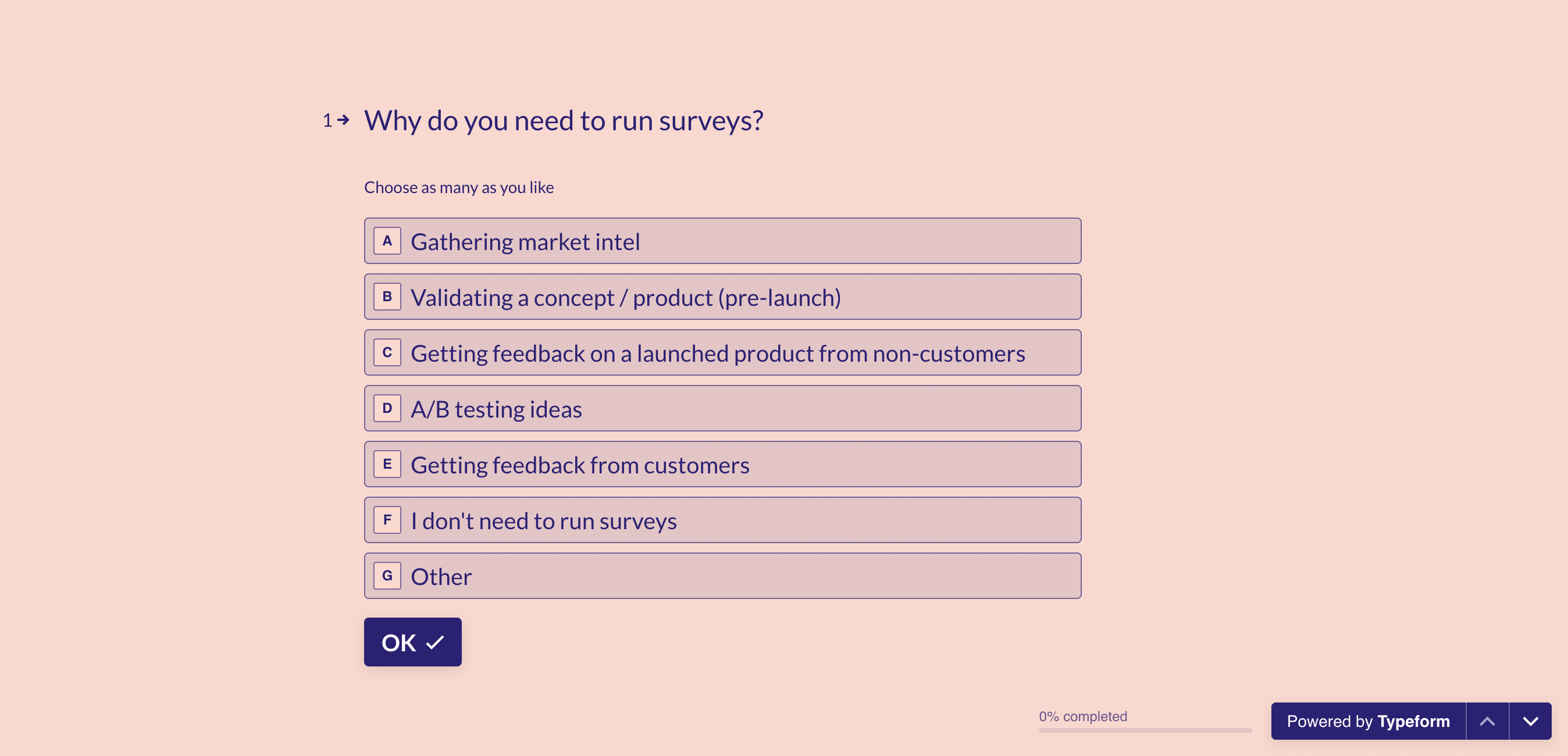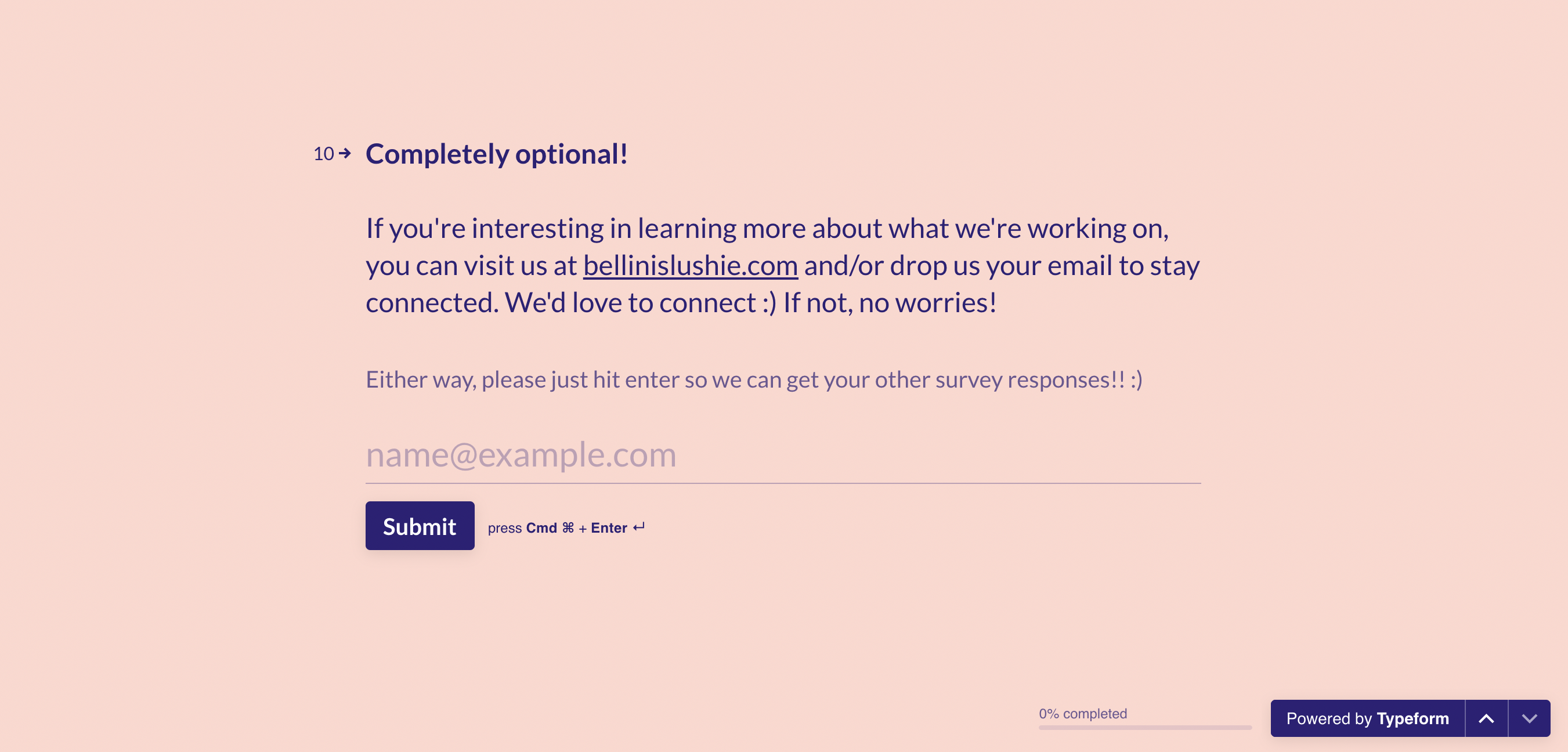How to write great questions for your form with Bellini Slushie
In this article, you'll learn the best practices for writing survey questions, as told by two experts in UX research.
You’re making a typeform, and it’s pretty easy... but you have this gnawing feeling that you are making mistakes when it comes to phrasing the questions. Or at least, that you don’t know exactly how to do it right.
You’re (probably) doing amazing sweetie! But like everything, there’s somewhere out there with the experience to do it better. Ali Grimaldi and Tzeying Cheng are the two UX professionals behind the Bellini Slushie question bank, and they have written hundreds upon hundreds of market research surveys. Here are their top tips for writing your own typeform questions.
First off: what are we shooting for? According to Ali and Tzeying, great survey questions:
- Generate unbiased data
- Encourage participants to actually finish the survey (or at least, don’t put them off)
- Generate data you’re confident is from people in your target market
Make sure this data is going to be useful to you
Beware of biased questions
This is the big one. It’s surprisingly easy to ask questions in a way that encourages people to agree with a conclusion you’ve already decided on. For example:
“How much do you like yoga?” This is a biased question, because it’s phrased positively. It assumes that the default attitude towards yoga is “like.”
“How do you feel about yoga on a scale of 1 (I hate it) to 10 (I adore it)?” This is an unbiased question, because it allows participants to feel all of the feelings without implicit judgement.
If you can, ask someone who doesn’t care about your project to check your questions for bias. Results from biased survey questions will give you false confidence in your assumptions, and won’t be helpful in the long run. As with so many things in life, if you aren’t prepared for the honest answer, it’s best not to ask at all.
Use multiple choice questions where you can
Ali is very passionate about this one! In her opinion, many open-ended questions can be turned into multiple choice questions with a little research. You may feel like making a survey is your research, but actually, doing some initial googling to scout out answers you’re likely to see can make your survey data a lot easier to work with.
For instance, if you ask “Where do you buy yoga pants?” as an open-ended question, you’ll probably get a whole spectrum of answers. Someone will tell you they get them from a local shop called Yogi’s, someone else will say that they buy them online, someone else will describe how theirs were “borrowed” from an ex-girlfriend…The range of interpretation will be huge, and preparing your data for presentation will be tricky.
If you can turn this into a closed-ended, multiple-choice question, you will get data you can slice ‘n’ dice. Perhaps after talking to some people in your target audience and running a few Google searches, you will learn that people often buy yoga pants online, through an Instagram ad, or from a shopping mall. Perhaps this was the information you need to know, rather than anything more complex about your respondent’s relationship with their yoga pants. And if your research doesn’t quite cover all the customers’ answers...that’s what the “Other (please specify)” field was made for.

Make sure you know who you’re talking to
Ask who is out there
In general, you should whittle away every non-essential question. But there are some questions which remain unwhittlable, even though the answers won’t be juicy: basic demographic information.
As Tzeying pointed out, you should never assume that you know who is at the other end of the typeform, even if you’ve only promoted it with targeted ads. Otherwise, you could get skewed results and be completely unaware.
But don’t get too personal
There’s a fine line between asking what you need to know, and being creepy -- again, as in life. Striking this balance when asking demographic questions is a very delicate act. Especially if you’re running a market research survey, where every new thing you know about your customer is a clue as to how to win them over.
The more personal your question gets, the more likely your participant will drop off. According to Tzeying, the #1 question that causes drop-off is….“What is your email address?”

Make sure your participants actually finish the darn thing
Keep it under 10 questions
Life’s most beautiful moments tend to happen when you’re not answering a typeform. The second someone loads your form, you’re racing against their urge to go and do something else. Ali and Tzeying mentioned that your survey should be as short as possible, but as a general rule, under 10 questions. And no more than two of them should be open-ended.
Highlight the benefit of taking your survey
The duo both mentioned the importance of getting someone to want to take your survey. They must feel like they’re going to get something valuable from spending a few moments of their time on this. If you’re using this research to build the best possible adventure vacation, sell your wanderlust. If you can phrase it as a personality quiz, that’s a fun idea people will be open to. If you can offer any kind of incentive, incentivize away.
It’s worth saying a third time: limit the open-ended questions
Open-ended questions are much more effort for a participant to answer. The more open-ended questions you have, the higher your drop-out rate is likely to be.
In Ali’s experience, people won’t give full, helpful answers to long answer questions unless you’ve provided something to respond to that triggers an emotion. That could be:
- After your participant just experienced something -- a product or service, maybe.
- As a follow up after your participant has given a rating: what made you feel that way? What was the experience like?
- On a complaints form!
Copy these expert researchers’ homework
If you’ve read this far and are feeling disappointed, then maybe you were hoping for more specific advice. Like, “when you’re asking what industry someone works in, use these fifteen industries'', kind of advice.
I direct you to the Bellini Slushi question bank, where Ali and Tzeying have curated 100 of the most common survey questions, to be downloaded and used for free.


